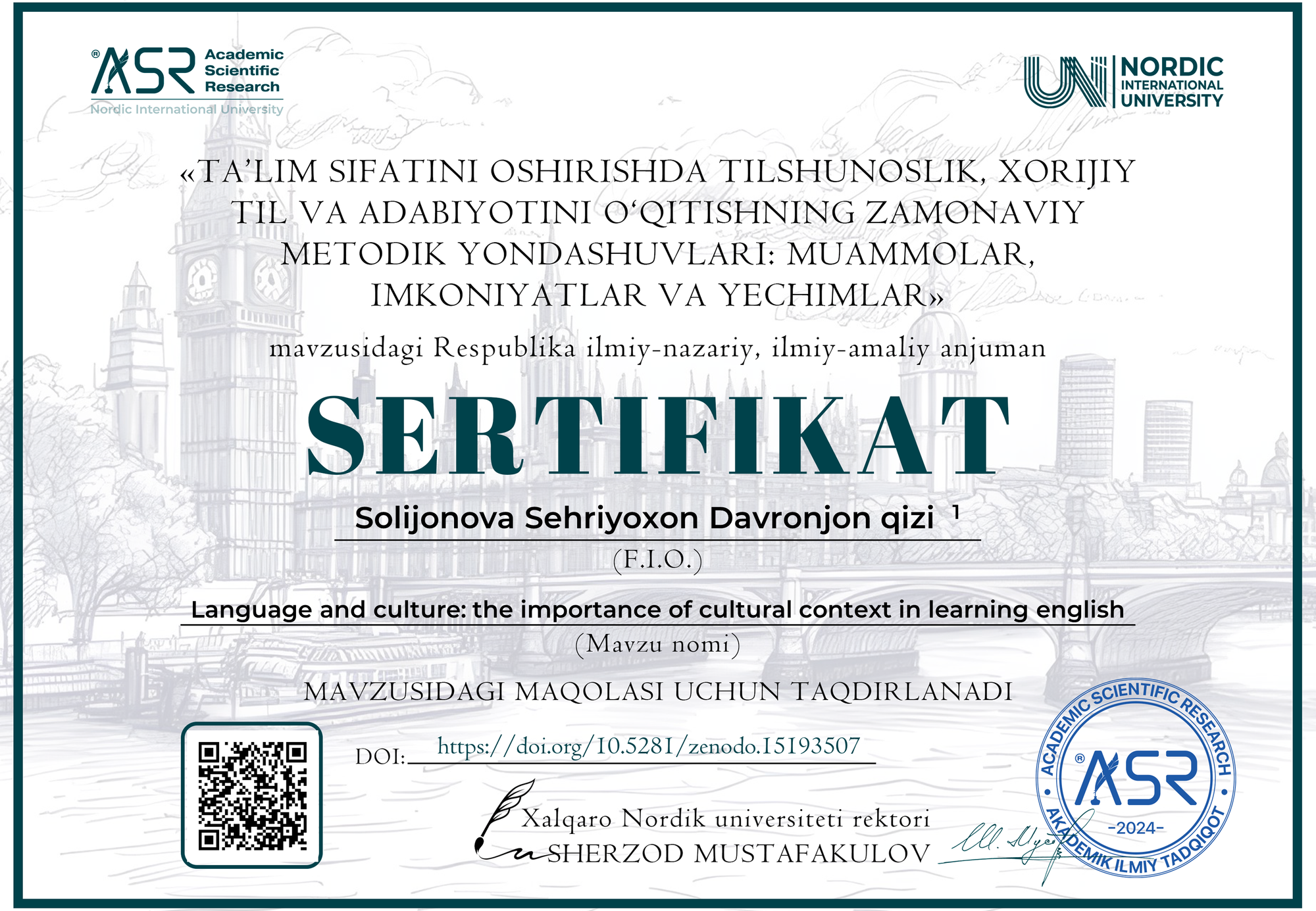Solijonova Sehriyoxon Davronjon qizi 1

DOI: https://doi.org/10.5281/zenodo.15193507
Zenodo community: https://zenodo.org/records/15193507
Nordic_press journal: https://research.nordicuniversity.org/index.php/nordic/article/view/2315
MAQOLANI YUKLAB OLISH
SERTIFIKATNI YUKLAB OLISH
REVIEW:
Solijonova Sehriyoxon Davronjon qizi's article, Language and Culture: The Importance of Cultural Context in Learning English, offers a compelling exploration of the essential role cultural context plays in mastering the English language. The author effectively argues that language learning extends beyond grammar and vocabulary and emphasizes that understanding the cultural nuances and social norms of English-speaking countries is crucial for effective communication.
The article begins with a clear premise: language is not just a tool for communication but a reflection of cultural identity. The author outlines how English, as the most widely spoken language globally, has been shaped by the diverse cultures of its speakers. Through the lens of English as a second language (ESL), Solijonova highlights the importance of cultural context, focusing on aspects like idiomatic expressions, humor, and social practices that are deeply embedded in the language. For example, expressions like “break the ice” and “spill the beans” cannot be understood literally and require knowledge of cultural references to grasp their true meaning.
The literature review in the article provides valuable insight into the connection between language and culture. Solijonova draws on the work of prominent scholars such as Kramsch (1993) and Byram (1997) to underline that language reflects societal values, traditions, and social norms. The article references the Sapir-Whorf hypothesis, which posits that language shapes thought, further supporting the claim that understanding English requires an awareness of the cultural worldview it embodies. This connection between language and culture is fundamental for ESL learners, who may struggle to comprehend idiomatic expressions or respond appropriately in social contexts without this knowledge.
Solijonova also discusses the significant benefits of cultural awareness. Culturally rich materials like films, TV shows, and books help learners understand the language in context, bridging the gap between theoretical knowledge and practical communication. Exposure to diverse accents, idioms, and cultural practices enhances learners' ability to use English confidently and effectively in real-world scenarios.
The article also addresses the challenges teachers face when integrating cultural context into language lessons. With the variety of English-speaking cultures, educators must navigate between universal norms and region-specific differences, such as the informality in American English versus the more formal expressions in British English. Moreover, limited access to authentic cultural materials can hinder the teaching process. Despite these challenges, Solijonova asserts that cultural competence is just as crucial as grammar and vocabulary in language acquisition. She emphasizes that learners who understand social norms—such as when to use formal or informal language—are better equipped to engage in meaningful conversations.
A notable strength of the article is its exploration of how technology can bridge cultural gaps in language learning. Platforms like HelloTalk and Duolingo provide interactive experiences, connecting learners with native speakers and offering exposure to cultural content. However, the author advises that educators guide learners to approach cultural differences with an open mind, fostering respect and avoiding stereotypes.
In terms of recommendations, the article provides practical strategies for integrating cultural context into English language teaching. These include incorporating authentic materials, highlighting cultural differences between English-speaking regions, encouraging online exchanges with native speakers, organizing cultural activities, and fostering intercultural competence. These strategies aim to make language learning more interactive, engaging, and culturally enriching.
In conclusion, the article reinforces the inseparable link between language and culture and emphasizes the importance of cultural context in learning English. Solijonova argues that cultural awareness not only enhances comprehension but also fosters effective communication in real-life situations. Despite the challenges in teaching cultural context, the article makes a compelling case for its inclusion in the language learning process. By embracing cultural education, educators can better prepare learners for the globalized world, where effective communication and mutual respect are key.
Overall, this article is a valuable contribution to the field of language education. It provides a well-rounded perspective on the vital role cultural context plays in mastering English and offers practical recommendations for educators to enhance their students' intercultural competence.



